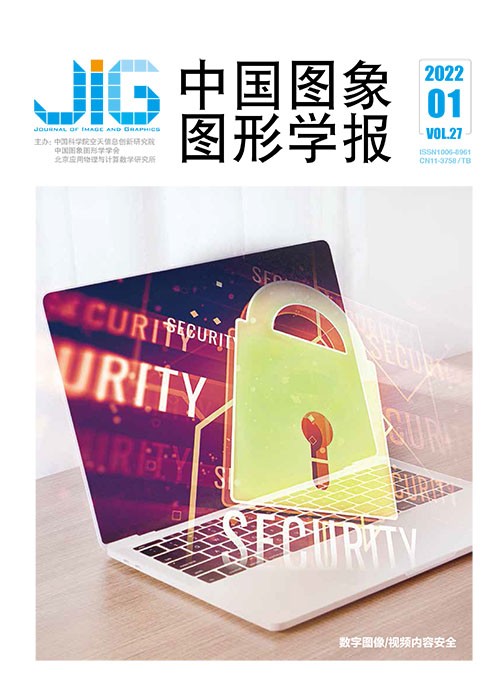
实离散分数Krawtchouk变换及其在数字图像水印中的应用
摘 要
目的 传统Krawtchouk变换处理图像时存在变换域信息表示单一、不可调节等问题,传统分数阶Krawtchouk变换处理实信号表示有冗余等问题。为了构造更加灵活的图像变换域表示,提出了实离散分数阶Krawtchouk变换,并应用于数字图像水印。方法 利用对传统Krawtchouk变换矩阵特征值分解的方式,通过对分解后的特征值矩阵的实矩阵分数化构造得到了实离散分数阶Krawtchouk变换的变换矩阵,从而构造出实离散分数阶Krawtchouk变换。然后,利用所提变换从实数域变换到实数域这一特性,提出了在实离散分数阶Krawtchouk变换嵌入水印信息的图像水印算法。算法采用了图像分块处理的方式,对每个图像块的实离散分数Krawtchouk变换系数进行奇异值分解,将水印信息嵌入奇异值分解矩阵中,然后进行逆向实离散分数阶Krawtchouk变换得到嵌入水印后的图像。结果 通过比较所提实离散分数阶Krawtchouk变换域水印算法和传统Krawtchouk变换域水印算法,提取水印的平均错误率在中值滤波、均值滤波、高斯滤波、JPEG压缩和缩放攻击下,分别降低了12.39%、10.04%、18.50%、71.49%和17.60%。结论 实验结果表明,提出的实离散分数阶Krawtchouk变换域水印方案对中值滤波、均值滤波、高斯滤波、JPEG压缩和缩放等多种信号处理攻击具有较好的鲁棒性。
关键词
Real discrete fractional Krawtchouk transform with an application to image watermarking
Liu Xilin, Wu Yongfei, Xiao Xiangyu, Xiao Jialong, Wang Hejin(College of Data Science, Taiyuan University of Technology, Taiyuan 030600, China) Abstract
Objective The transform domain based on information embedding technique has been demonstrated to design robust image watermarking algorithm, which aims to make copyright protection and identify the ownership of the image. For Krawtchouk transform (KT), it converts the real-valued image domain to real-valued transform domain. Its transform domain just represents the stationary information of the image domain. To represent more the image domain information dynamically, the original KT has been extended to discrete fractional Krawtchouk transform (DFrKT) with two more degree of freedom known as fractional orders. DFrKT has been used in many image and signal processing applications. But, more storage memory is required because it converts the real-valued image domain into the complex-valued transform domain during images processing. This research has extended the KT to propose the real discrete fractional Krawtchouk transform (RDFrKT). The RDFrKT inherits the merit of DFrKT and KT. The RDFrKT can hold the property of fractional order determined transform domain and obtain real-valued transform domain representation of image as well. Moreover, an image watermarking algorithm is designed and applied via embedding watermark information in the RDFrKT domain. The effect of RDFrKT for the watermarking algorithm is also compared with the original KT- based image watermarking algorithm.Method The RDFrKT has been constructed via taking the real fractional order form of the eigenvalue matrix of KT transform because the eigenvalue decomposition based fractional transform construction method has been proved as an effective way. This construction procedure is as following:First, the transform matrix of KT is performed by eigenvalue decomposition, which generates one eigenvalue matrix and two eigenvector matrixes. Next, the real fractional form of eigenvalue matrix is constructed to generate the RDFrKT transform matrix. Then, the two eigenvector matrixes and the fractional form of eigenvalue matrix are combined so as to generate the RDFrKT transform matrix. A gray image watermarking scheme is designed to embed watermark information in images based on the proposed RDFrKT. The watermarking algorithm employs a block-based watermark embedding strategy. First of all, the original image is divided into 4×4 image blocks, followed by the RDFrKT transform of each block. Second, the singular value decomposition (SVD) is performed on the RDFrKT transform domain of each block, generating one singular value matrix and two singular vector matrixes, known as left singular vector matrix and right singular vector matrix. Third, the watermark is embedded into the first column of the left singular vector matrix of each block. Finally, the watermarked image is acquired via combining the modified left singular vector matrix with the singular value matrix and right singular vector matrix, followed by inversely transforming the modified RDFrKT coefficients to the image domain. The watermark extraction procedure can be regarded as a reversed procedure of the watermark embedding scheme. The received image is divided into 4×4 image blocks. The RDFrKT is performed on each block with fractional orders with the watermark embedding scheme matching. SVD is conducted on the RDFrKT transform domain of each block. The watermark bit can be extracted from the first column of the left singular vector matrix.Result Based on the public gray image database of Granada University, the proposed RDFrKT-based watermarking algorithm with the same watermark embedding strategy replacing the RDFrKT by discrete cosine transform(DCT) and KT respectively. Moreover, the proposed method is compared with the state-of-art Hu's method. The quantitative evaluation metrics include peak signal to noise ratio (PSNR) and bit error rate (BER) to evaluate the performance of the proposed RDFrKT-based watermarking method. By embedding watermark information in the test image such that the average PSNR of the watermarked images is 37.58 dB, which customized the watermark invisible requirements. The watermarked image is submitted into various image manipulation and attack situations, including median filter, average filter, Gaussian filter, JPEG compression, image rescaling, salt and peppers noise and Gaussian noise. Watermark is extracted from the attacked watermarked image to verify the robustness of the watermarking method. BER is used to measure the robustness of the watermarking method. A smaller BER value represents qualified robustness performance. By comparing the KT based method and the proposed RDFrKT based method, The illustration shows that the average BER of the proposed RDFrKT based method dropped by 12.39%, 10.04%, 18.50%, 71.49%, 17.60%, respectively, corresponding to the attack situations of median filter, average filter, Gaussian filter, JPEG compression, and image scaling.Conclusion The proposed RDFrKT has evolved the real-valued transform domain property of initial KT and the fractional order manipulated transform domain property of DFrKT. As one application method of RDFrKT, a gray image robust watermarking algorithm has been designated that embeds watermark information in the RDFrKT domain. The demonstration shows that RDFrKT-based watermarking method has better performance to deal with interferences circumstances a, such as median filter, average filter, Gaussian filter, JPEG compression, and image scaling.
Keywords
real discrete fractional Krawtchouk transform (RDFrKT) Krawtchouk transform (KT) image watermarking fractional transform information hiding
|



 中国图象图形学报 │ 京ICP备05080539号-4 │ 本系统由
中国图象图形学报 │ 京ICP备05080539号-4 │ 本系统由